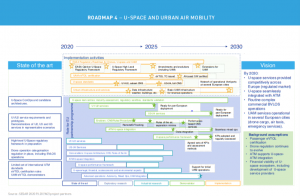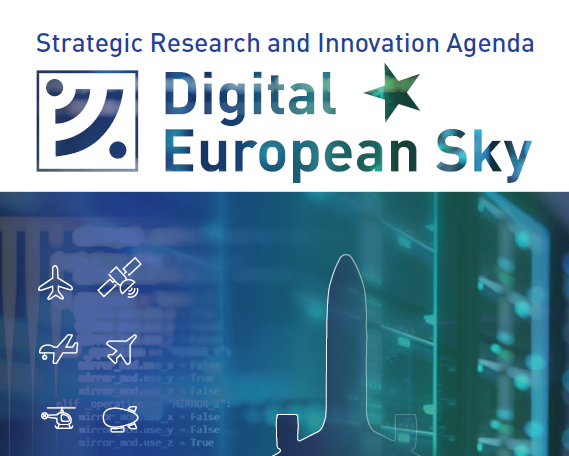The latest draft of the Strategic Research and Innovation Agenda (SRIA) for the Digital European Sky, published in November 2020 by members of the Single European Sky ATM Research (SESAR) JU, highlights the outstanding research areas which will be needed to define appropriate technologies, procedures and standards before more complex (U3 and U4) levels of U-space management can be introduced, paving the way for autonomous beyond visual line of sight (BVLOS) operations, flights above people and full integration of UTM with ATM.
With the first wave of U-space programmes sponsored by the agency now largely complete (with the exception of BUilding Basic BLocks for a U-Space SEparation Management Service (BUBBLES); Demand and Capacity Optimisation in U-space (DACUS); and Integrated Common Altitude Reference systems for U-Space (ICARUS) https://www.unmannedairspace.info/latest-news-and-information/drone-projects-secure-eur1-4-million-eu-funding-in-horizon-2020-exploratory-research-programme/) Europe’s research leaders have now identified the next priority areas. According to the report:
“Many questions still need to be answered before full-scale deployment is feasible, particularly in the areas of interoperability, certification and performance requirements, safety and security, fairness, contingency management, financing and liability…. The required technologies to enable performance-based CNS services in U-space need to be identified and assessed in operational environments. For example, the use of mobile communication technology, such as 5G, and other emerging technologies for connectivity should be studied, as well as data link solutions to enable electronic conspicuity and surveillance. Different solutions for separation management for all types of vehicles in all types of airspace (including airborne detect and avoid (DAA) as well as ground-based and hybrid solutions) should also be considered.
“One of the key research questions is how to integrate the airspace autonomous operations over populated areas safely into complex and congested airspace environments, with operations involving vehicles interacting with U-space and conventional ATM services. Research should investigate how U-space can support the transition from piloted to autonomous operations (linked to EASA AI Regulatory Roadmap….The safety, security, certification and regulatory challenges arising from the provision of U-space services to manned aircraft should be studied. Information exchange will be critical to enable a safe convergence of U-space and ATM. Challenges include cybersecurity, data compatibility and the reconciliation of different standards and certification requirements. Another critical aspect of the integration will be the role of the human, particularly regarding the high level of automation that will be delivered by U-space services and the automation disparity between ATM and U-space.”

While the first wave of U-space research has been pivotal in helping States introduce U1 and U2 levels of service the time is tight for researchers to investigate and recommend technologies, procedures and standards for developing U3 and U4 services, with industrialisation of these expected to start in 2022 and to continue at least until 2030. This is designed to bring about harmonised deployment and operations between the late 2020s and 2035, and beyond. But with many research budgets being cut and staff laid off as a result of the COVID-19 pandemic, the task of organising demonstration programmes in these critical and complex areas is likely to prove far more difficult than in the first wave.
The text below, which applies to U-space and UAM traffic management research, is taken directly from the SRIA document.
Mature, validate and deploy across Europe the basic U-space services: The set of U-space services has been divided into 4 levels (U1 – U4) of increasing sophistication and complexity: U1, which includes services such as registration, remote identification and geo-fencing; U2, which encompasses services such as flight planning, flight approval, tracking, and the interface with conventional air traffic control; U3, with advanced services supporting more complex operations in dense areas, such as traffic prediction and capacity management as well as assistance for conflict detection and resolution (automated detect and avoid functionalities); and U4, with services still to be defined that will support high levels of autonomy and connectivity as well as integration with manned aviation and ATM. Although descriptions of many services exist at U1, U2 and even U3 levels, and a concept of operations (ConOps) shows how they can fit together, work is still needed on validation, cost benefit analysis and standardisation. Although different U-space architectures have been proposed, work is still required to assess different options and identify those that meet the full range of requirements by the different types of operations and guarantee safe and secure interoperability, thereby enabling a pan-European competitive environment for the provision of U-space services. One of the challenges is to enable the simultaneous operations of multiple U-space service providers (USSP) in the same airspace. In addition to the definition of potential U-space architectures, preliminary implementations of U1 and U2 services have already been demonstrated in the SESAR 2020 programme. Eurocontrol is collecting data from States to assess their progress towards deployment (as part of the EU Network of U-space demonstrators initiative, led by the EC), which has so far been limited. Many questions still need to be answered before full-scale deployment is feasible, particularly in the areas of interoperability, certification and performance requirements, safety and security, fairness, contingency management, financing and liability.
Develop advanced U-space services: In parallel to the full validation, industrialisation and deployment of the basic U-space services, work needs to start on the definition, design and development of advanced services. The most advanced U-space services (U3/U4) will enable UAM missions in high-density and high-complexity areas. The required technologies to enable performance-based CNS services in U-space need to be identified and assessed in operational environments. For example, the use of mobile communication technology, such as 5G, and other emerging technologies for connectivity should be studied, as well as data link solutions to enable electronic conspicuity and surveillance. Different solutions for separation management for all types of vehicles in all types of airspace (including airborne detect and avoid (DAA) as well as ground-based and hybrid solutions) should also be considered.
Enable urban air mobility (UAM): The requirements of UAM operations are expected to be the most challenging for the U-space ecosystem. One of the key research questions is how to integrate the airspace autonomous operations over populated areas safely into complex and congested airspace environments, with operations involving vehicles interacting with U-space and conventional ATM services. Research should investigate how U-space can support the transition from piloted to autonomous operations (linked to EASA AI Regulatory Roadmap). The evolution of U-space together with its associated regulatory framework and standards will need to be synchronised and coordinated with the development of the future UAM ConOps, its associated UAM services and the certification of UAM vehicles. Special consideration should be given to the operational limitations of these new vehicles and how U-space can contribute to operational safety by protecting their operation in contingency and non-nominal situations. In addition, mechanisms and protocols to enable Collaborative Decision Making in the context of UAM, involving ATM, U-space and city stakeholders, will need to be explored.
ATM/U-space integration: U-space services shall enable safe and efficient operations of unmanned aircraft without negatively impacting the operations of other airspace users. The seamless integration of U-space and ATM services is expected to contribute to the fairness, safety, efficiency and environmental impact of the overall air traffic system. The capacity benefits and flexibility of an airspace without segregation requires the full integration of U-space and ATM. For U-space and ATM environments to be integrated, it does not necessarily mean they operate in the same way. They could be very different indeed, but with suitable interfaces to allow safe and effective coexistence. Standard operating procedures will need to be defined (for example rules of the air and airspace management) to allow manned and unmanned aircraft to share the same airspace safely, as well as the simultaneous provision of U-space and ATM services). The safety, security, certification and regulatory challenges arising from the provision of U-space services to manned aircraft should be studied. Information exchange will be critical to enable a safe convergence of U-space and ATM. Challenges include cybersecurity, data compatibility and the reconciliation of different standards and certification requirements. Another critical aspect of the integration will be the role of the human, particularly regarding the high level of automation that will be delivered by U-space services and the automation disparity between ATM and U-space. In addition to the key challenges described above, the following transversal research areas will be critical to the successful development and deployment of U-space.
Financial and legal aspects: Research needs to be conducted on potential U-space and drone operator business models, focusing on the mechanisms required to create a fair and competitive U-space market across Europe. The available alternatives for the financing of a sustainable U-space ecosystem should be analysed, including how to optimise public and private investments and the implications for the financial model of European ANSPs. The insurance models required for U-space should also be analysed.
Social acceptance: Work is required to ensure that the new operations enabled by U-space are acceptable to the public. Specific areas of concern will be UAM noise, visual pollution, privacy, etc. In addition, a consensus must be reached on the acceptable target level of safety of the different types of operations under U-space. The impact on general and leisure aviation should also be considered.
CNS and separation minima: Definition and validation of performance-driven CNS requirements for operations under U-space, together with the applicable separation minima. The separation minima will be related to the CNS performance, available separation management services and other relevant criteria – ground risk, vehicle performance, etc. Validation of CNS technologies against the performance criteria.
Support the development of the U-space regulatory framework and required standards: Leverage extensive modelling, simulation and experimentation to assess the maturity and interoperability of U-space services, assess different deployment options and support their industrialisation and deployment. Create U-space test centres offering an environment for stakeholders to conduct reproducible and interoperable tests in conditions comparable to live operational scenarios, with the objective of validating standards and regulations in representative environments. Such centres can also support the certification of new U-space service providers, services or technologies, making it possible to increase flexibility for rapid and agile increments of the U-space ecosystem.
Transfer of U-space automation technology to ATM: Explore whether U-space can be an accelerator of the ATM innovation life cycle, facilitating faster, lower risk adoption of new technologies or approaches (automation, AI, cloud, etc.).
U-space performance framework: A performance framework for U-space needs to be defined in concordance with the overall SES performance framework, so as to assess and guide the deployment process based on objective and quantifiable performance measurements.
Safety assurance: New safety modelling and assessment methodologies applicable to U-space are needed. Tools are required to analyse and quantify the level of safety of U-space operations involving high levels of automation and autonomy, where multiple actors automatically make complex, interrelated decisions under uncertainty (e.g. weather-related uncertainty). Research is needed to ensure that the distributed decision-making protocols implemented in U-space achieve the required level of safety while catering for differing levels of experience of participants. Examples of approaches that could be leveraged for this purpose include greater use of simulation and machine learning applications such as stress-testing.
Applications above VLL airspace: Explore potential applications and extensions of U-space concepts beyond VLL airspace, for example to support manned traffic in uncontrolled airspace or to enable high altitude operations.
For more information
https://www.sesarju.eu/node/3697




